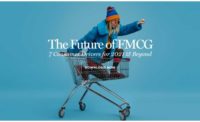Brand Packaging
Who is the “Future Consumer”?
If there has been one certainty of the last couple of years, it’s that of uncertainty. Terms like “remote working” are commonplace, guest bedrooms have been turned into home offices and e-commerce has become the norm. The impact has been felt socially, economically and commercially and consumer behavior is changed.

SeanZeroThree / iStock via Getty Images Plus
For brands, understanding the immediate and future impact on consumers in this new landscape can feel like a re-learning. Interestingly, a white paper by trend forecasting experts WGSN, called Future Consumer 2024 has identified the main consumer ‘sentiments’ and distilled them into the key consumer profiles set to prevail by 2024. Here we translate the main findings and pose reflections for brands keen to remain relevant in rapidly changing times.
Future Consumer 2024: The Key Sentiments
- Future Shock: A rise in ‘meta-economies’ and a blurring of lines between physical and digital worlds, will create a sense of anxiety and unease. For people working from home, that boundary between home life and work life can become uncertain and, as early as the fall of 2020, research was showing that people were finding it increasingly difficult to ‘shut off’, as well as sensing increased levels of loneliness and stress.
- Overstimulated: The change in working patterns and social habits, as well as the lack of physical contact with others during lockdowns, have led to a shift in our senses and their adaptation to our environment. At the same time as the lack of real-world stimulus, there has been a sharp uptick in digitalization and social media and, specifically, more short-form content. ‘TikTok brain’, where still-developing teenage brains are being primed to become addicted to the feel-good effect of watching short videos, is being seen to impact on attention span and ability to focus on more productive activities.
- Tragic Optimism: Coined by Holocaust survivor Viktor Frankl, ‘tragic optimism’ refers to man’s search for meaning in the most tragic of circumstances. With a constant news relay of pandemic, war and political unrest, compassion fatigue feels very real. This cumulative sense of burnout, an emotional burnout, prompts people to seek for the meaning in the chaos, as well as a means to cope. This goes beyond self-care and looks for the growth in times of uncertainty — the creation of a new world.
- Awe: A state of wonder and inspiration necessary for change — and survival. It’s a state that brings people together and creates connection. A feeling of awe shifts beyond the individual into a much broader, external perception. In contrast to social disconnection and feelings of isolation and anxiety, creating a state of awe has been shown to produce pro-social and positive emotions — an ‘anxiety-antidote’.
These four key sentiments and attitudes, when distilled further into key behaviors, determined four main consumer profiles:
1. The Regulators
They seek a sense of control as a coping mechanism in a world of friction and overwhelm. It’s said that 90% of the world’s data has been produced in the last two years — and consumers are feeling the ‘data smog’. For Regulators, as change becomes a daily constant, they’re seeking consistency in their home and work life.
THE REPORT IDENTIFIED TWO KEY WAYS TO ENGAGE REGULATORS:
Store hailing: See this as the next step on from click and collect. Where your basket ‘favorites’ are unavailable or items forgotten, products can be scheduled for curbside delivery for the ultimate, friction-free ecommerce experience.
Voice commerce drives home commerce: Imagine seeing the ideal outfit on your favorite TV hero or heroine and being able to shop it right then and there by voice command. As overwhelm creates friction between the consumer and ecommerce, frictionless solutions such as social commerce and shoppable TV will create opportunities for forward-thinking brands.
Reflection: How can brands echo that yearning for familiarity and consistency? How can brands make it easy to be the frictionless choice?
2. The Connectors
Redefining the meaning of success, the Connectors see times of crisis as a means to disrupt and create new ideas and ways of working aligned to their values of work-life balance. Instead of success measures of more, more, more — and burnout as a by-product — the Connectors are ‘rebelling’ with an attitude of ‘just enough’ to cover essentials and rejecting traditional measures of success and lifestyle aspirations — such as marriage and children. Instead, they’re choosing ‘fractional lifestyles’, such as co-buying homes, cars and workspaces with a like-minded group.
ENGAGING CONNECTORS LOOKS LIKE:
- Rethink of labels and hangtags: Step aside food labeling, Connectors are looking for Sustainability Facts labeling as a must-have.
- The dawn of DAOs: That’s decentralized autonomous organizations to you and me. Connectors reject the idea of singular ownership of resources and instead will look for decentralized alternatives with community at the heart.
Reflection: How can brands visually communicate transparency across sourcing and sustainability of ingredients and packaging, as well as responsibility across the supply chain? How can brands engage consumers in decision-making to foster the sense of community ownership?
3. The Memory Makers
If the future looks uncertain and the present is chaotic, the Memory Makers look for stability in the known of past experiences. It’s created an opportunity to reflect and consider life choices and, for some, created a sense of ‘lockdown remorse’ — a questioning of life choices. This drives the Memory Makers to make up for lost time and to spend time with those that matter the most — and ‘declutter’ those that don’t.
Memory Makers are redefining what family means to them, more as something you create rather than born into, as well as rethinking work values.
ENGAGING MEMORY MAKERS LOOKS LIKE:
- Investing in the care economy: Products and services that help people ‘age well’ and enjoy their time living, as well as a focus on inclusion - supporting aging communities in non-traditional and re-defined family structures.
- Bank on the group-buying boom: A rise in multi-generational living or new family structures create savvy consumers to seek out ways to save money.
Reflection: How can brands design products with a broader and more inclusive feel to meet diverse needs and perspectives? How can products for aging consumers communicate messages of joy and living well, rather than more ‘clinical’ or health credentials, as primary motivator?
4. The New Sensorialists
Embracing new technologies and the meta-verse, the New Sensorialists have their feet in both the physical and digital world. They’re the first to embrace cryptocurrency, VR experiences and they’re advocates for the next generation of the internet — Web3. This decentralized web and social media alternative puts users in control of their data and privacy rather than current centralized models.
New Sensorialists have a sense of excitement at the ‘disruption’ created by the pandemic and see it as an opportunity for creativity — a creative renaissance. It gives rise to more digital design and opportunities for artists to express beyond traditional industry borders — for example, music artists seeking ways to interact with games, TV, film. It’s a catalyst for the creator economy with a keen eye on inclusivity and equity for those contributing their art.
ENGAGING NEW SENSORIALISTS LOOKS LIKE:
- Meta loyalty rewards: These consumers are found in shopping malls and meta malls. They’re adopting digital wallets and influenced by direct-to-fan buying models.
- Feeling the meta verse: It blurs the lines between the physical and digital, the meta verse will become more sensory - opportunities to create more immersive experiences abound.
Reflections: How can brands play with creativity and be seen in new spaces that make sense to consumers? How can products meet consumers where they are — both in store and in meta-malls?
Utilizing these macro trends, along with our real-time insight and feedback from brands, gives our Equator teams context to inspire creative and agile solutions for brands in this changing environment. Finding time to think was a key need identified in consumers across the board - we’re optimistic that time for reflection on these macro trends can help us to work with brands to develop solutions that appeal to these new consumer dynamics. Exciting and creative opportunities lie ahead.
Looking for a reprint of this article?
From high-res PDFs to custom plaques, order your copy today!








